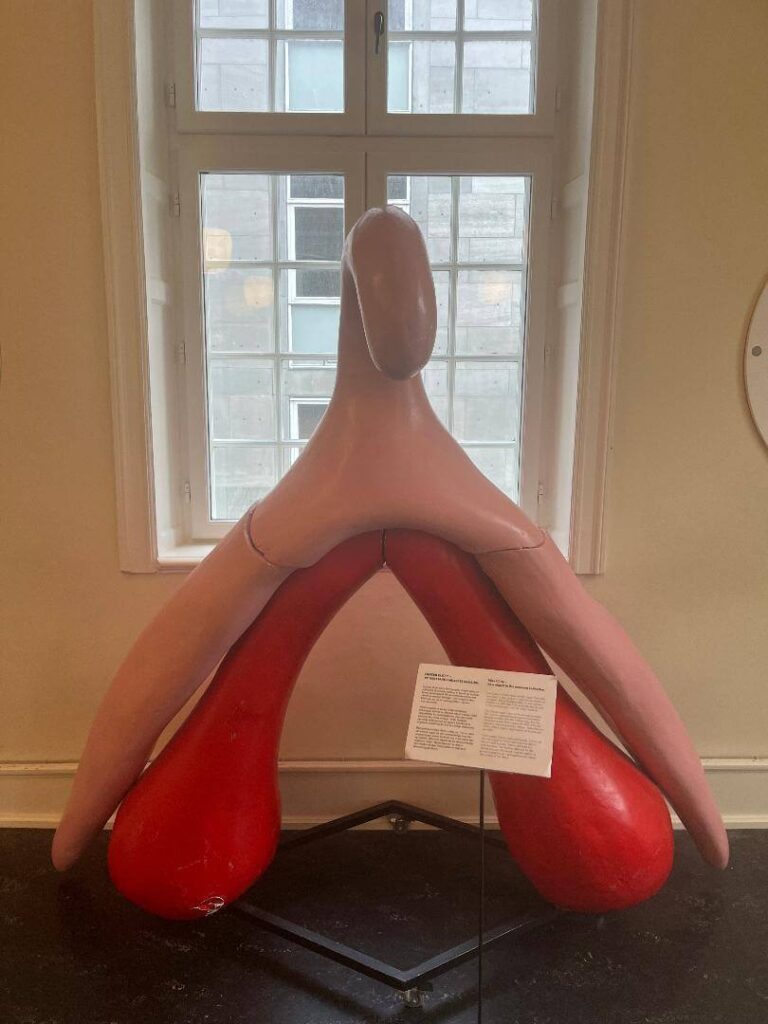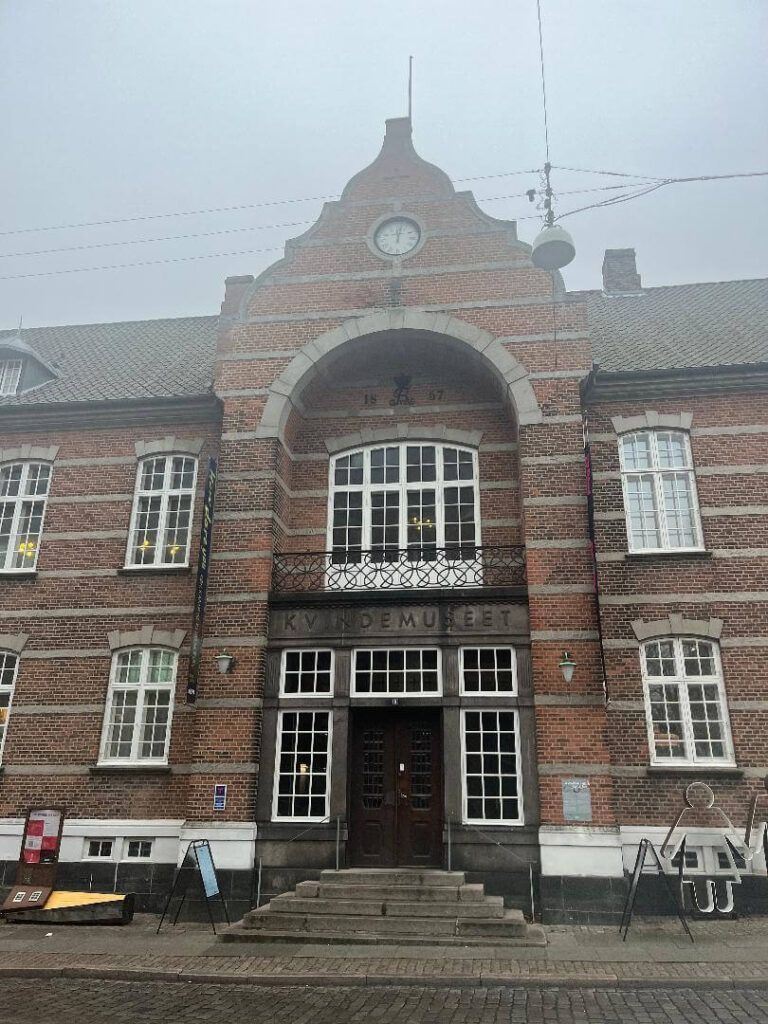Kvinde, Ken din plads (Women, know your place)
I am staring at a metre-high model of a clitoris. It’s painted bright red and pink and is, as the Danes say, meget smuk (very pretty). Insert joke of your choice here.
 If you’ve started twitching a bit and wondering anxiously where this column is going, it‘s ok. I’ve felt the same in a number of frank conversations in Denmark about topics ranging from fashions in pubic hair to menopause and ageing. I’m that awkward person thinking “Are we allowed to discuss pubes in Danish class?” We are quite repressed in the UK, and Danes are… not.
If you’ve started twitching a bit and wondering anxiously where this column is going, it‘s ok. I’ve felt the same in a number of frank conversations in Denmark about topics ranging from fashions in pubic hair to menopause and ageing. I’m that awkward person thinking “Are we allowed to discuss pubes in Danish class?” We are quite repressed in the UK, and Danes are… not.
The Giant Clitoris (Kæmpe Klitoris, apparently, in Danish) is one of the displays at KØN, Denmark’s Gender Museum, in Aarhus. The museum, which first opened its doors in 1982 as the Kvindemuseet (Women’s Museum) is one of the only museums dedicated to the history of gender in the world. I’ve been meaning to visit for ages, then finally went last Tuesday, the day of the US elections. Ah, how differently the world looked less than two weeks ago. I’ve seen all sorts of comments online along the lines of “Well, Kamala Harris and her policies didn’t connect with ordinary working people.” So, what? A convicted criminal guilty of multiple counts of fraud who also stands accused of sexually abusing over 24 women did? It’s difficult to see this as anything other than an anti-woman, anti-Black stance. All of us, all over the world, now have to consider how Trump’s second Presidential term might affect us. For those of us who are female, non-white or part of the LGBTQ+ community, watching Trump handing out powers like slik (candy) to transphobes and misogynists, that feels really quite frightening indeed.
It also feels frightening to make any kind of “at least that will never happen here” statement. However, statistics literally show that Trump wouldn’t have been elected in Denmark. 96% of Danes polled said they would have voted for Kamala Harris. Even in the U.K., that figure was significantly lower at 68%. Right now, as a queer woman, Denmark feels like one of the best places I could be living. In search of light and optimism, anywhere, this week, I decided to come back to KÖN.
 Denmark has a strong track record on gender equality and is currently ranked 3rd of 27 EU countries. It has a long history of progressive law-making, giving women the vote before many countries including the UK and electing, in 1924, the world’s first female government minister, Nina Bang. Denmark decriminalised homosexuality as far back as 1933 (for comparison, in Scotland it was illegal until 1980) and, sixty years ago, the Danes solved the childcare crisis that still prevents many women in the UK and the US from progressing in the workplace. Denmark was also the birthplace of the earliest known recipient of gender-affirming surgery, Lili Elbe, who was born not far from my home, in Vejle, Jutland, in 1882.
Denmark has a strong track record on gender equality and is currently ranked 3rd of 27 EU countries. It has a long history of progressive law-making, giving women the vote before many countries including the UK and electing, in 1924, the world’s first female government minister, Nina Bang. Denmark decriminalised homosexuality as far back as 1933 (for comparison, in Scotland it was illegal until 1980) and, sixty years ago, the Danes solved the childcare crisis that still prevents many women in the UK and the US from progressing in the workplace. Denmark was also the birthplace of the earliest known recipient of gender-affirming surgery, Lili Elbe, who was born not far from my home, in Vejle, Jutland, in 1882.
The statistics and historical record tell a positive story, but statistics can be manipulated and they do not always give a full picture. Similarly, legal rights count for little if they’re not upheld by the institutions of power, which women in the US have found out the hard way this week. The UK government could produce a range of impressive-looking statistics and laws on gender equality too. A bigger question is what that looks like in reality. What does it actually feel like to live in a country if you are not a rich, white, straight man? What does life look like? How much of public policy is lip service and how much actually underpins everyday life, every day?
One of the biggest differences I notice between the UK and Denmark when it comes to gender is in the apparent willingness of men to share the domestic load. I see men, everywhere, juggling their toddler expertly at 8am parent-school meetings, calmly doing the supermarket shop with kids in tow, in other words taking on “the crap”. Danes would put a more positive spin on it, but what I mean is all the unseen, dull labour that keeps the wheels of family life turning. In the UK, this is a woman’s world. This year, I signed up to be a Class Parent at my kids’ school. My co-Class Parent is a man with a very busy job, yet he still remembers to send the Whatsapp reminders to all the other parents to “bring bike helmets” and “it’s Christmas Craft Day everyone – don’t forget your scrap paper and ribbon”. This would generally not happen in the UK if there was a woman in the vicinity of the task.
 The roles of men and women in the workplace is another area where I notice a distinct difference. I spent years working in education, talking to teenagers about their future plans. It was almost impossible to convince girls they could be construction engineers or boys they could be nursery teachers. No matter what affirmative content we displayed on the school careers website, the society around them gave very different messages. Last week, I went with the 13-year old to a careers talk about manufacturing apprenticeships at a popular international toy company near us (who could it be?). Two of the five presenters were women. One of them was in a senior manufacturing role. The other was an apprentice who spoke with a gleam in her eye about how she wanted her job so much that she “stalked the company like a crazy ex-girlfriend”. There was something so refreshing for me about a young woman being obsessed with her factory job rather than obsessing over a man or her appearance. When it was time for questions, I almost said something about how positive it was to see women represented at an event like this, but then I realised this isn’t unusual in Denmark. Women do all sorts of jobs here that I never saw in the UK. A couple of days ago I stopped my car at some traffic lights in Vejle, my nearest Big City, and saw a woman in her early twenties with a blonde topknot down a hole in the middle of the road with some tools. My eyes drifted left and I saw a middle-aged man in charge of a class of pre-school children, waiting to shepherd them across the road. It was like someone had set it up for a diversity advert, or I just made it up for this column, but I promise I didn’t. It just happened. It’s normal here.
The roles of men and women in the workplace is another area where I notice a distinct difference. I spent years working in education, talking to teenagers about their future plans. It was almost impossible to convince girls they could be construction engineers or boys they could be nursery teachers. No matter what affirmative content we displayed on the school careers website, the society around them gave very different messages. Last week, I went with the 13-year old to a careers talk about manufacturing apprenticeships at a popular international toy company near us (who could it be?). Two of the five presenters were women. One of them was in a senior manufacturing role. The other was an apprentice who spoke with a gleam in her eye about how she wanted her job so much that she “stalked the company like a crazy ex-girlfriend”. There was something so refreshing for me about a young woman being obsessed with her factory job rather than obsessing over a man or her appearance. When it was time for questions, I almost said something about how positive it was to see women represented at an event like this, but then I realised this isn’t unusual in Denmark. Women do all sorts of jobs here that I never saw in the UK. A couple of days ago I stopped my car at some traffic lights in Vejle, my nearest Big City, and saw a woman in her early twenties with a blonde topknot down a hole in the middle of the road with some tools. My eyes drifted left and I saw a middle-aged man in charge of a class of pre-school children, waiting to shepherd them across the road. It was like someone had set it up for a diversity advert, or I just made it up for this column, but I promise I didn’t. It just happened. It’s normal here.
The other major difference I see is in attitudes to women’s appearance and beauty. Girls and women wear clothes they’re comfortable in. They don’t replace their entire wardrobes because some influencer told them to – ultra fast, disposable fashion sold by the likes of Primark in the UK doesn’t actually exist in Denmark. Women don’t walk about with faces thick with make-up they’ve spent an hour and a half applying. This is a true story: in the UK I worked with lots of girls who wouldn’t do sport at school because they’d ruin their make-up and they didn’t have time to reapply it. I’ve never worn less makeup than I do here, and friends say the same. There are no lips inflated to cartoon-like levels. Older women wear their grey hair proudly and stylishly. When they smile, their faces move and they have visible lines. Women take up space too. They sit with their legs wide open: they don’t contort themselves into the tiniest shapes they can in order to appear thinner. They often look, with their stylish, practical hair and well-made, comfortable, all-weather clothing, like the stereotype of a lesbian in the UK. I hesitated to write this because in my home country, this would be an insult. Nothing is worse, apparently, than being a woman who looks like a lesbian. But what nobody seems to have considered is maybe all women would “look like lesbians” if they didn’t feel such pressure from the patriarchy to conform to capitalism’s latest passing trend in femininity. Maybe “looking like a lesbian” is actually just looking like a woman who is in control of her own life and destiny. In Denmark, too, women freely talk about their age. I found it jarring at first to be asked repeatedly “Hvor gammel er du?” in Danish class. Then I realised: Danish people don’t see age as a shameful thing. For them it’s not connected to a woman’s value. I feel that for older women in particular, Denmark is a really great place to live. The first time we came here as a family, when we had no idea we’d be living here, we ate lunch in a restaurant largely taken up by a group of about 20 women in their 60s and 70s, talking loudly, laughing and drinking beer. And pretty much all of them looked like the UK’s stereotype of a lesbian. I’ve seen my Old Lady future and it looks like that.
It’s so difficult to work out how another society could create this. Where would they start? What KØN, the gender museum in the heart of the city that was once the town hall, shows is the commitment over time to the importance of equality. “Women, know your place,” a poster in the entrance hall states. KØN, like Danish women, takes up space: it covers over three floors and 1200 square metres, all devoted to documenting the history of women and gender in Denmark. You could spend a day here and still not do justice to everything it has to offer. It shows women and LGBTQ+ people that their past, present and future matters. “This museum is a safe space,” one of the plaques on the ground floor states, and if ever we needed a safe space, it’s surely now, in the wake of Trump’s return to world power. The range of exhibitions at KØN includes an interactive room devoted to sex education that’s intended for school groups. This is where Miss Clitty, the Giant Clitoris, lives so she can educate all who visit her. Then there is a gallery focusing on the Redstockings, the Danish feminist movement of the 1970s and 80s whose legacy lives on in what it feels like to be a woman and a queer person in the country today. One large room invites visitors to explore gender stereotyping and how they feel it affects them. It has a photo gallery including a lot of pubic hair. An exhibit revisiting the building’s original purpose as the old Town Hall reminds us, “Democratic history is likewise gender history. Who is included and excluded in the democratic process?” Indeed, Donald Trump. Indeed.
I bought the “Women, know your place” poster to hang in my house. When I look at it I’ll be reminded that as hard as it can be at times to be an immigrant living away from family and friends, I really do feel that as a queer woman about to hit 45, Denmark is the best country for me to be. I’m glad as well that my two sons get to spend their teenage years here. Next time I go to KØN, I’ll take them too. There will probably be questions, especially about Miss Clitty, and I’ll do my best to answer them, Danish style, with full, unembarrassed frankness!
Read more about KØN here: KØN






